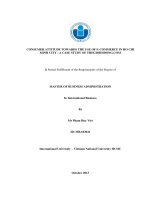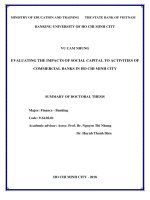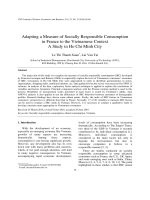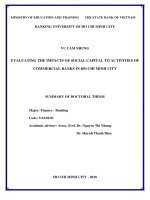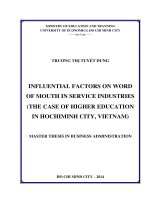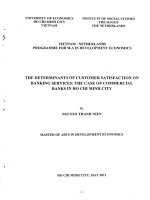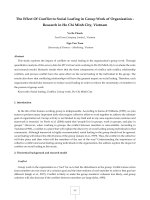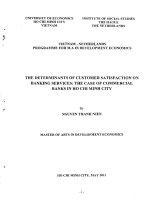The development of hue cuisine in ho chi minh city
Bạn đang xem bản rút gọn của tài liệu. Xem và tải ngay bản đầy đủ của tài liệu tại đây (22.87 MB, 62 trang )
MINISTRY OF EDUCATION AND TRAINING
HO CHI MINH CITY UNIVERSITY OF FOREIGN LANGUAGESINFORMATION TECHLONOGY
DEPARTMENT OF TOURISM - HOSPITALITY
CQ@~
Graduation Paper
The Development of Hue Cuisine in Ho
Chi Minh City
FULL NAME: TU THUY BICH TRAM
CLASS: DL1101
STUDENT CODE: 11DH490080
ADVISOR: MS. NGUYEN TID NGOC THUY
HUFLlTLIB
1111111111111111111111111111
101001390
j
'
.•
Ho Chi Minh City
2015
MINISTRY OF EDUCATION AND TRAINING
HO CHI MINH CITY UNIVERSITY OF FOREIGN LANGUAGES INFORMATION TECHLONOGY
DEPARTMENT OF TOURISM - HOSPITALITY
"C'll@ro
Graduation
Paper
The Development of Hue Cuisine in Ho
Chi Minh City
FULL NAME: TU THUY BICH TRAM
CLASS: DL1101
STUDENT CODE: 11DH490080
ADVISOR: MS. NGUYEN THI NGOC THUY
Ho Chi Minh City
2015
ACKNOWLEDGEMENT
This research was only possibly made thanks to the enthusiastic support and
encouragement of many individuals and organizations. Therefore, I would like to express
my gratitude for their great assistance.
Firstly, I would like to give my sincerest thanks to my parents, who were always by
my side and encouraged me during my studies from primary school to university,
especially during the time I carried out this research for my graduation.
Secondly, I am thankful to Ms. Nguyen Thi Ngoc Thuy - my advisor - for her
advice about the topic. I want to say thank you because she spent her time to instruct,
suggest and comment on my idea as well as correct my mistakes.
Thirdly, I highly appreciate the great help from other teachers at the School of
Tourism and Hospitality Management such as Miss. Pham Thi Thanh Uyen, Mrs. Vo Thi
Duy Khanh and Mrs. Huynh Thi Kim Hoa as well as my boss - Mr. Nilson Kothe and my
colleagues at ILl English Center. Thanks to their opinions, suggestions and support, I
could improve secondary resources collection and logic idea arrangement to accomplish
my research in the best way.
Last but not least, I would like to give my sincere thanks to my friends at the
Tourism and Hospitality Department of HUFLIT University for their encouragement
while I was doing my research.
Tu Thuy Bich Tram
ABSTRACT
Ho Chi Minh City is a big and famous city in the South of Vietnam. This city is very
popular with not only for its culture, history, people, tourist attractions but also for its
diversified gastronomy from everywhere throughout Vietnam. Among many kinds of
culinary cuisines available in this city, Hue cuisine attracts tourists the most because of
its uniqueness and preciseness. It is considered that Hue cuisine is very developed and
successful in Ho Chi Minh City. Therefore, this research has been calTied out in order to
present Hue cuisine's uniqueness arid preciseness, which cannot be mistaken with any
other dishes in this country, as well as its development in Ho Chi Minh City.
In this research, primary data and secondary data were used. The primary data was
mostly obtained from a survey by questionnaires, which lasted for nearly three weeks
from 24th March to 6th April 2015. The subjects of the survey were 300 people randomly
in Ho Chi Minh City. Besides, information, data and statistics from books, reports,
newspapers, magazines and websites were also examined as secondary data.
The findings revealed that over 80% of people in Ho Chi Minh City liked Hue
cuisine because of its uniqueness in ingredients and cooking recipes, especially seasoning
recipe. The survey also pointed out that nearly 80% of people in Ho Chi Minh City have
been impressed by Hue dishes.
Those results have proved that Hue cuisine has developed and succeeded strongly in
Ho Chi Minh City. However, the study also found out some problems such as food
hygiene, bad serving manners, and overcharging. Therefore, a number of activities
should be suggested to solve the problems as well as to spread Hue dishes' images
throughout Vietnam and into the world with the aim of developing Vietnam's tourism.
TABLE OF CONTENTS
Page(s)
Table of Contents
.i
List of Tables and Figures
:
Chapter I: Introduction
.iii
1
1.1
Background
1
1.2
Statement of The Problem and Objective
1
1.3
Scope and Significance of The Study
2
1.4
Research questions
2
Chapter II: Literature Review
3
2.1
Overview of Hue cuisine in Ho Chi Minh City
3
2.1.1 Origin of Hue cuisine
3
2.1.2 The spread of Hue cuisine from the Central to the South of Vietnam
..................................................................................................................
2.2
2.3
3
The factors affecting Hue cuisine and its changes in Ho Chi Minh City
.4
2.2.1. Ingredient selection and combination
4
2.2.2. Spices selection
6
2.2.3. Dish seasoning
9
2.2.4. Food decoration in Hue cuisine
10
2.2.5. Serving and enjoying Hue dishes
11
The developing situation of Hue cuisine in Ho Chi Minh City
13
2.3.1 The popularity and success of Hue's cuisine in Ho Chi Minh City
13
2.3.2 Some obstacles affecting the development of Hue's cuisine in Ho Chi
Minh City and their consequences
2.3.3 Some methods to broadcast Hue specialties in Ho Chi Minh City
;.14
.15
Page (s)
Chapter III: Research Methodology
18
3.1
Overview of Research Method
18
3.2
Sample and Technique
18
3.3
Material and Procedure
18
3A
Statistical Treatment.
19
Chapter IV: Results
20
4.1
General information
20
4.2
Factors affecting Hue cuisine and its changes in Ho Chi Minh City
23
4.3
The attractiveness of Hue cuisine in Ho Chi Minh City to tourists
27
404
Problems affecting Hue cuisine's development in Ho Chi Minh City and
4.5
solutions
30
Hue cuisine's adveliisement in Ho Chi Minh City and its benefits
.33
Chapter V: Discussion
36
5.1
Objective
36
5.2
Findings and Explanation for Findings
36
5.3
Recommendation for Hue cuisine's promotion in Ho Chi Minh City
38
5A
Limitation of The Research
39
5.5
Implications of The Research and Suggestions for further Researches
AO
Chapter VI: Conclusion
Al
References
43
Appendix A: Questionnaires in English version
046
Appendix B: Questionnaires in Vietnamese version
51
11
LIST OF TABLES AND FIGURES
Page(s)
Table 4.1: Opinion of respondents toward Hue cuisine
20
Figure 4.2: The popularity of Hue dishes
21
Figure 4.3: Time of day to enjoy Hue dishes in Ho Chi Minh City
22
Figure 4.4: Factors affecting the uniqueness of Hue cuisine
23
Figure 4.5: Tastes affect the uniqueness of Hue dishes
24
Figure 4.6: How to eat Hue dishes in Ho Chi Minh City
25
Figure 4.7: How to serve Hue dishes in Ho Chi Minh City
26
Table 4.8: The impression of Hue dishes towards tourists in Ho Chi Minh City
27
Figure 4.9: Different kinds of Hue dishes and places to enjoy them in Ho Chi Minh City
................................................................................................................................................
28
Figure 4.10: Different sources to find out Hue dishes in Ho Chi Minh City
29
Figure 4.11: Problems affecting Hue cuisine's development in Ho Chi Minh City
30
Figure 4.12: Consequences of the problems relating to Hue cuisine in Ho Chi Minh City
.............................................................................................................................
;
31
Figure 4.13: Solutions for the problems affecting Hue cuisine's development in Ho Chi
Minh City
32
Figure 4.14: The popular methods to spread Hue cuisine in Ho Chi Minh City
33
Figure 4.15: Benefits after spreading Hue cuisine in Ho Chi Minh City
34
Figure 4.16: The best places to spread Hue cuisine's image in Ho Chi Minh City
35
111
CHAPTER I
Introduction
1.1 Background:
Vietnam is a famous country with a long-standing history, a diversified culture and
developing tourism, especially in recent years. There are numerous tourist attractions in
Vietnam that are recognized across the world. One of the most famous and interesting
destinations that was recognized by UNESCO as World Heritage Site in 1993 is Hue. It is
well-known as the ancient capital of Vietnam with wonderful attractions, but especially
for its cuisine.
Hue cuisine includes cooking recipe, food processing, food decoration and how Hue
people serve and enjoy it. It is unique and multiform with hundreds of different dishes
consisting of both rustic ones and delicacies. Each dish contains its personal elegance
from ingredient selection and food processing stages to seasoning and decoration stages.
For those characteristics, Hue dishes are very popular with not only domestic tourists but
also international travelers. Understanding the potential of Hue cuisine towards tourism
development, people in many places spread it from Hue city to other areas of Vietnam
and developed it strongly to attract more tourists. At present, hundreds of different Hue
dishes can be found in many places throughout Vietnam.
1.2 Statement a/The Problem and Objective:
Although Hue cuisine has developed in most areas of Vietnam, there are not many
places serving the best Hue dishes to meet all the tourists' interests and expectations
because of their complicated cooking process. However, Ho Chi Minh City is one of a
small number of cities that has had big success in developing Hue cuisine. So, what
factors affect the uniqueness of Hue cuisine and how Hue dishes developed in Ho Chi
Minh City are always big questions that stimulate everyone's curiosity. Thus, the aim of
this research is to introduce the elegance and preciseness of Hue dishes in Ho Chi Minh
City. Moreover, the research also investigates the popularity and attraction as well as
developing situation of Hue cuisine in this city.
1.3 Scope and Significance of The Study:
Although many studies have been done on Hue food culture, there is not much
information on Hue cuisine that is available in Ho Chi Minh City. Therefore, this study
has been carried out on regular tourists in Ho Chi Minh City to point out the uniqueness
of Hue cuisine expressed through its ingredients, spice, cooking recipe, food decoration
and even how to serve and enjoy it. Furthermore, the success of Hue cuisine in Ho Chi
Minh City, some problems that affect Hue cuisine's development, solutions for those
issues, and several methods to spread Hue dishes' image to people living in this lively
and famous city are also pointed out in this study. Once this research is done, it hopefully
will provide more useful knowledge related to the food culture of Hue, especially
information about the real situation of Hue cuisine's development in Ho Chi Minh City.
Moreover, it also supplies information about the factors influencing the specialty and
uniqueness of Hue dishes to both domestic and international tourists.
1.4 Research questions:
In this paper, I will attempt to answer the following five questions:
a.
What are the factors impacting on the uniqueness and elegance of Hue cuisine?
b.
How did Hue dishes become popular in Ho Chi Minh City?
c.
What are problems affecting Hue cuisine's development in Ho Chi Minh City?
d.
What are solutions for the problems?
e.
How to advertise Hue cuisine to tourists in Ho Chi Minh City?
2
CHAPTER II
Literature Review
2.1 Overview of Hue cuisine in Ho Chi Minh City:
2.1.1 Origin of Hue cuisine:
Located in the North Central of Vietnam, Hue is a big and famous city ofThua
Thien - Hue. It was the imperial city of the Nguyen Dynasty in the South of Vietnam
from the 1ih to the 19th century. According to Huu Ngoc and Lady Borton (2012, pp.1213), during three centuries, Hue was the royal capital of upper and middle classes.
Therefore, it has created very unique and elaborate culinary culture.
Food in Hue is a combination of the quintessence of culture not only in North
Central of Vietnam but also in other regions. That is because Vietnamese people from the
Red River Delta, Thanh Hoa and Nghe Tinh immigrated to Thuan Hoa with Lord Nguyen
Hoang and brought their eating and drinking customs with them (Van Thang, 2013).
Through a long period of time, their cuisine integrated with the cuisine of people living in
Thuan Hoa to create a very unique food culture. Besides, as presented by Ngo Minh
(2012), according to history, before becoming the home of Vietnamese people, Thuan
Hoa - Hue was the home of ancient kingdom of Champa. Therefore, the food culture of
Cham people also affected the elegance and uniqueness of Hue cuisine.
2.1.2 The spread of Hue cuisine from the Central to the South:
Because Hue dishes contain the specialty and preciseness that is not similar to those
in other areas, Vietnamese people in many places have studied the recipes and made Hue
dishes to attract tourists. Thus, Hue cuisine started to develop dramatically and has spread
to many other areas from the North to the South of Vietnam. The South has been the area
that developed Hue dishes in the fastest and strongest way. Tieu Kieu (2008) commented
that nowadays, many dishes of the ancient capital have become very popular in a lot of
Southern cities. On most of crowded and lively avenues or small alleys, there were a lot
of restaurants, food stalls or hotels selling Hue dishes. People could enjoy delicious tastes
of dumplings with shrimp wrapped by leaves, clear dumplings with pork and shrimp, rice
with mussels, beef noodle soup, lotus seeds sweet soup and so on. Those were unique
3
dishes that attracted Southern people and decreased homesickness of Hue people who
lived far away from their homeland. Among a lot of cities in the Southern area, Ho Chi
Minh City is where Hue cuisine has developed the most.
Nevertheless, Hue dishes in Ho Chi Minh City have not followed the original recipes
strictly and have adequately changed to suit the taste and hobbies of people here. Take
Hue beef noodle soup as an example. As illustrated by Tieu Kieu (2008), Hue beef
noodle soup can be found everywhere in Southern region. When arriving to this area, it
has been changed a little to suit Southern people's tastes. Beef noodle soup in Hue had
much shrimp paste, chili, beef, pork ribs, pork bologna, crab bologna and so on. The
bowl of noodle soup was small enough for full stomach in breakfast or snack in the
afternoon. The bowl of noodle soup in Southern area was bigger and had more meat as
well. Some cooks added pork bologna or grilled meat roll following guests' requirements.
Hue beef noodle soup in the South had less shrimp paste and less spicy taste because
Southern people did not like shrimp paste smell and fiery taste.
Because of some little changes, Hue cuisine in Ho Chi Minh City has its personal
uniqueness and specialty.
2.2 Factors affecting Hue cuisine's uniqueness and its changes in Ho Chi Minh City:
The cooking process is considered a difficult challenge to a cook. To succeed in
cooking Hue dishes, the cooks need to have both good knowledge and cooking skills in
order to choose good ingredients, use appropriate spices, combine food precisely, and
decorate dish skillfully.
2.2. I Ingredients selection and combination:
The ingredients which are used to create Hue dishes inust be fresh. Xuan Huy (2004,
p. 476) stated that Hue is located in an advantageous location which has plains,
mountains, and ocean. Therefore, ithas a diversified source of ingredients. Dong Ba
market has a large variety kinds offood from vegetable, fruit, fish, crab to squid, shrimp
great delicacies brought from the forests or the sea. Those fresh foods are supplied to
many housewives for processing and cooking. Thus, Hue dishes are always very
4
I
with garlic. In Ho Chi Minh City, however, the cake is covered by fresh shrimp and
grease with spring onion. The cracklings are replaced by crisp sandwich. The sauce is
transparent served with a dish of green chili.
Despite of some little changes, Hue dishes in Ho Chi Minh City still attract a lot of
tourists because the cooks still retain the main ingredients, especially the Ying and Yang
balance that form specific characteristics of Hue cuisine in each dish.
2.2.2 Spices selection:
The tastes in Hue are quite different in comparison with other regions. There, the
tastes are clearly distinguished from salty, sweet to spicy and bitter. Those tastes are
considered as the tastes of life of people in Hue. Although Hue people use a lot of tastes
in their dishes, three out of them are the most important and popular. Those are spicy,
salty and sweet. Authors Vu Ngoc Khanh and Hoang Khoi (2012, p.213, para.9) also
made it clear that the specialty of Hue cooking recipe is using many spices while
cooking. Because the natural conditions, history and people in Hue are different in
comparison with other areas in Vietnam, Hue people's taste are more spicy, salty and
sweet.
2.2.2.1 Spicy taste:
Among three main tastes of Hue cuisine, spicy is the most essential one forming the
uniqueness of Hue cuisine. Mr. Thang stated in the article Hue cuisine - Hue delicious
th
dishes: Remembering the spicy taste of Hue city on 4 November, 2013 that Hue dishes
have many spices. Each dish has a different kind of spice but the most popular one is
chili. In Hue, most dishes have a spicy taste. Beef noodle soup or rice spaghetti for
breakfast is always red because of the chili in them. Rice or vegetable soup for lunch has
chili as well. People also find chili and feel its spicy taste in clear dumplings with shrimp
and pork or stuffed rice pancakes for dinner. Hue people like eating spicy dishes and they
find this kind of taste pleasant. This kind of taste is so important that many people believe
that it is not a Hue dish if it does not have a fiery taste. The author Thuy Trang clarified
in the article The simplicity of Hue chili sauce on 9th February, 2015 that the specific
6
characteristics of Hue cuisine are spicy taste and the colorful images of red and green
chili. If there is no chili, it is not a Hue dish.
Many people wonder why Hue people like eating spicy dishes like that. The main
key to answer that question is geography. Hue people started to eat spicy food when their
ancestors moved to Thuan Hoa region. They studied from Cham people about using spicy
seasoning (especially chili) to harmonize weather and living environment in the new
place. Until now, they still like to use this kind of taste to primarily keep their body warm
because the winter in Hue is very cold. As Buu Ngon (2004, p.191) stated, in the winter,
Hai Van mountain range in Southern Hue stops cold clouds from the North. As a result, it
creates lasting rains weekly from August to January. On those days, Hue people and
tourists do not want to go out because of the cold climate. Ifwe have a chance to travel to
Hue in cold season or lasting raining days, we can understand that feeling. Nevertheless,
the weather in Ho Chi Minh City is hotter than that in Hue in raining or cold season.
Therefore, Hue dishes in Ho Chi Minh City tend to be less spicy food than those in Hue.
Take Hue beef noodle soup as an example, the broth of noodle soup in Hue is covered by
the red color of chili. On the other hand, the red color of noodle soup in Ho Chi Minh
City is from Achiote - a kind of seed creating red color for food without spicy taste.
2.2.2.2
Salty taste:
Hue people like salty taste as well. They always use fish sauce, salt and shrimp paste
in most of their dishes. Therefore, it is not strange to know that Hue people have various
kinds of salt to create a salted rice party and shrimp pastes to eat in each season of a year.
In most of Hue people's meals, we can see there is always a small bowl offish sauce on
the table. In the article Hue people's tastes, it was reported that Hue people like salty
taste very much. In every meal, they always ask the cook to serve a bowl of salty fish
sauce. When the cook forgets to serve the fish sauce, they will satirize him or her by
saying that "No one is selling Nam
a fish sauce today"
("Some tastes of Hue people",
29th July, 2011). In addition, shrimp paste is also a special dish that no one can omit
whenever they talk about Hue cuisine. Hue is considered as "homeland of shrimp paste"
because within more than 100 special Hue dishes, there are about 14 kinds of shrimp
pastes. All of them are simple and rustic ones which are often remembered and
7
mentioned when talking about Hue cuisine. In The cuisine365. vn - the channel of life, it
was reported that Hue shrimp pastes have become specialties of the ancient capital. They
have also been integral condiments of many Hue families for a long time because of its
simplicity and rusticity. They are just normal and familiar shrimp pastes made from
shrimps and fish, but every people can recognize their special and delicious taste; that is
the unforgettable salty taste like the sentiments and feelings of Hue people ("Buying Hue
shrimp paste at Dong Ba market", 2013). Not only fish sauce and shrimp pastes but salta very ordinary spice - also has become very famous. Only with rice and many different
kinds of salt, Hue people can create a unique salted rice party. This shows that Hue
people appreciate salty taste as an integral taste that contributes to Hue cuisine success.
However, the salty taste in Hue dishes has lessened after spreading to Ho Chi Minh City
because the people here are not get used to eat very salty dishes.
2.2.2.3 Sweet taste:
Besides salty and spicy taste, sweet taste is also a very important taste in Hue
cuisine. Its importance is expressed through more than 30 kinds of Hue sweet soup. There
are no places in Vietnam that have so many kinds of sweet soup than Hue.
Hue sweet soups are made mainly from many kinds of bean and cereals which are
very common, easy to find and, especially, very good for health. They also have a quite
simple cooking recipe, such as kidney bean sweet soup, green bean sweet soup or taro
sweet soup and so on. However, the finicality is the most popular characteristic of Hue
people. Therefore, there are still many types of sweet soups that are sophisticated and
elegant from ingredients to cooking ways such as some sweet soups made from lotus
seeds, longans or even roasted meat. Those features were mentioned by Huu Ngoc and
Lady Borton (2012, p.58) that in the past, chefs at the royal palace and at the homes of
rich, aristocratic families usually cooked sophisticated and refined sweet soups, including
lotus seeds sweet soup, longans stuffed with lotus seeds sweet soup and roasted meat
sweet soup. Previously, ordinary people only enjoyed simple and cheap dishes made from
grains and legumes.
8
Although Hue sweet soups have many different forms, they have the same
characteristic, that is, their sweet taste is very elegant and pure because the cook uses
rock sugar instead of normal types of sugar. Rock sugar is the integrate ingredient for
some sweet soups made from lotus seeds. In The cuisine365. vn - the channel a/life, it
was reported that Hue sweet soups are different from sweet soups in other areas because
they are cooked by rock sugar syrup. For lotus seeds sweet soup and longans stuffed with
lotus seeds sweet soup, the lotus seeds must be from Tinh Tam lake and longans must be
Hue big longans. Those ingredients will make the sweet soups have elegant sweet taste
and fragrance oflongans and lotus seeds ("The elegance of Hue sweet soups", 2011).
Even when arriving to Ho Chi Minh City, that kind of sugar is still used a lot by the local
to maintain the uniqueness and preciseness in sweet taste of Hue sweet soups. The sweet
taste of rock sugar is considered as a simple medicine that helps people who live in a hot
place like Ho Chi Minh City release their heat effectively.
2.2.3 Dish seasoning:
Seasoning is one of the most important steps creating the difference and elegance of
Hue food culture. Following Dr. Nguyen Nha (2009, p.80, para.7), most Hue dishes are
created by a lot of condiments. For example, Le le-hon dish includes 18 condiments
(pepper, spring onion, fish sauce, salt, sugar, white wine, soya bean sauce, five spice
powder, garlic, ginger, citronella, saffron, thick soy sauce, bamboo shoot, lotus seeds,
apple, shiitake mushrooms); or a simple fried dish with 15 spices. There are some spices
that their secrets may be known by Hue housewives only. For instance, bamboo shoot is
usually added to fermented shrimps; broad beans sweet soup should have ash - water;
Chinese braised pork is always served with orange. On the other hand, some dishes are
very simple but elegant such as gobies simmered with pepper or rice gruel have rustic
flavor like haiku poems of Japanese.
Hue people have used many spices in every dish like that because they want to
stimulate the taste of the eater and make the eater feel that the dish is more delicious.
Besides that, the spices can also be used to deodorize smell of fresh food like fish, shells,
meat and so on. By this way, the food will be more scented and attractive. Vu Ngoc
Khanh and Hoang Khoi (2012, pp.213-214) clarified that, obviously, the habit of using
9
many condiments in cooking has expressed the synthetic thinking of Vietnamese people
in general and Hue people in particular. It has helped to resolve three main requirements
in the art of cooking. Those are making dish become more delicious (stimulating taste),
deodorizing the fresh food's smell and creating fragrance (stimulating the smell),
decorating food by many colors (stimulating the sight).
However, to season correctly with the aim of attracting the eater, it requires the cook
to have practical experience and knowledge about weather or background to adjust the
amount of seasoning in each dish appropriately. Take Hue beef noodle soup as an
example, in the summer, the cook must reduce the amount of citronella. In addition, the
living condition also affects the taste of people. For instance, people in the countryside
are usually manual laborers, they work harder than the people in the cities. Therefore,
their tastes are more salty.
2.2.4 Food decoration in Hue cuisine:
Hue people usually enjoy foods by their eyes before tasting it by their tongues. It
means food decoration is vitally important in Hue cuisine. That is the most popular and
special characteristic of Hue people. In The quintessence of Hue cuisine on the website of
Net Hue restaurant, it was reported that eating and drinking of Hue people connect
closely to 3 criteria: cheap, delicious and especially beautiful. It is not a dish without
beautiful decoration ("The quintessence converges in Hue cuisine", 2014).
Each dish is a harmonization between appearance and color and is considered as a
colorful picture. When decorating dish, the cook always focuses on the setting up and the
color of food so that the dish can be more attractive and lively. According to Vu Ngoc
Khanh and Hoang Khoi (2012, p.215), when decorating a dish, Hue people usually focus
on arrangement of ingredients following specific symbols such as star, moon, earth,
flower, shrimp, chicken and so on. It not only shows a lively world and contains a spirit
meaning but also make the dish more beautiful and elegant. Furthermore, following Bui
Minh Duc (20 II, para.!), if a dish is put on a plate messily, Hue people will disparage
and consider it as unattractive dish although it is delicious. A delicious dish must be
decorated delicately. Milling pork must be decorated with a handful of coriander and
some slices of red chili to be more attractive. A plate of fresh vegetable is also a work of
10
art. Slices of green banana are put on edge of the plate while fresh vegetable is laid
inside. In the middle is some slices of star fruit, fig and some red chili to embellish the
vegetable plate. Besides, to make the dish become more beautiful and unique, the cook
also decorates dishes with birds, roses or phoenix made from vegetable and fruits. For
instance, rose is made from tomato, white dove is made from turnip, the pineapple is
made empty and has a candle inside, or water melon is always carved into daisy or rose
and so on. All of that contributes to the difference and uniqueness of Hue cuisine.
In Ho Chi Minh City, Hue cuisine's decoration is less complicated because the life
style of people here is more lively and hurried. The cook does not have much time for
decoration. They cannot spend hours to trim the vegetable or fruit into birds, flowers or
phoenix just for decorating a dish. Therefore, Hue dishes with sophisticated decoration
may only be available in luxury restaurants or some contests and festivals specializing on
Hue cuisine, not in daily meals like in Hue.
2.2.5 Serving and enjoying Hue dishes:
Besides cooking dish, how to serve and enjoy food is also part of the culinary art.
Hue people usually enjoy the food with moderate and courteous manner. It is the same as
personalities and characteristics of Hue people - profound and polite.
If we have a chance to have a meal with Hue people, we can see that eating and
drinking in Hue are very methodical. Hue people enjoy their meal deliberately, leisurely,
and quietly. The writer Ngo Minh mentioned in the article There is a philosophy in Hue
cuisine on 13th September, 2014 that Hue people are often unhurried while eating. When
eating noodle soup or Pho, they usually use chopsticks only to pick up foods and move
the bowls to their mouths to slurp soup. It is different from people in Hanoi and Ho Chi
Minh City who use both chopsticks to pick up foods and spoon to scoop the soup. Hue
people like to enjoy many dishes ina meal. For each dish, they just try a little as an
experience. Thus, although there are a lot of dishes in a meal, all of them have a little
quantity. That is also the reason why bowls and plates used in a meal in Hue are always
smaller than the ones in other areas. The author Mai Khoi (2002, p.8, para.8) clarifies that
the china-wares for a meal of Hue people are always small. That follows the inviting
guests rule. In a tray, the bowls or plates for food are usually small and contain a little
11
food; thus, the guests' bowls for rice are not bigger than the food bowls. If the cook uses
large bowls and plates, it will occupy a lot of space. As a result, it is inconvenient for Hue
people who like to eat many dishes at the same time but little amount of food from each
dish.
Even the use of Chinaware also shows the elegance of local people. Each kind of
Chinaware must suit each kind of dish. For instance, Dr. Nguyen Nha (2009, p.78,
para.5) pointed out that rice with mussels must be contained in terra - cotta bowl, beef
noodle soup is enjoyed by chopsticks only, bloating fern-shaped cake must be enjoyed in
small terra - cotta plate and bamboo knife, sticky rice is squeeze by hands, corn is
scooped by jackfruit leave, and lotus seeds sweet soup must be hold in a luxury porcelain
small bowl, soya is served in porcelain that has dragon pattern.
Not only must the Chinaware be suitable but the eating place and time must also be
appropriate. Hue people tend to appreciate eating and consider a suitable eating place is a
very important aspect. This is a different point between them and people in Ho Chi Minh
City who enjoy Hue dishes in anywhere they like. According to Dr. Nguyen Nha (2009,
p.78, para.6), as cited in Chau Nhat Nam (1997),when eating bloating fern-shaped cake
or plain rice flan, the eaters have to seat on a bamboo bed or meals in Double Five
festival must be set on mat, taro rice gruel or glutinous rice sweet soup must be enjoyed
on writing table, grilled sweet potato should be eaten next to rice husk stove or haystack,
lotus seeds sweet soup is enjoyed on couch, noodle soup and stuffed rice pancake must be
served and eaten in food stall.
In addition, eating timely is also a special thing that makes the difference. Hue
people do not eat in flexible time like Ho Chi Minh City people. According to Dr.
Nguyen Nha (2009, p.78, paraA), Hue people always eat beef noodle soup or rice gruel
for breakfast. Rice pancakes with salty taste are dishes for snacks. Balut is always eaten
in the evening and sweet soup is a dish for late at night. Hue people do not eat rice with
mussels for breakfast. They also do not eat bloating fern - shaped cake or clear
dumplings with shrimp and pork for a full stomach in main meals.
12
2.3 The developing situation of Hue cuisine in Ho Chi Minh City:
Ho Chi Minh City is not only a lively and modern city but also the home of cuisine
from everywhere in Vietnam. The cuisine in Ho Chi Minh City is diversified with
hundreds of specialties from the North, the Central and the South. Within those dishes,
Hue cuisine of Central Vietnam is very famous and special. After spreading to Ho Chi
Minh City, Hue cuisine made a very good impression towards domestic and international
tourists and Hue dishes are now considered indispensable ones in every meal of people
living in this city.
2.3.1 The popularity and success of Hue's cuisine in Ho Chi Minh City:
In recent years, Hue dishes have become very popular in Ho Chi Minh City. They
are not strange for people in Ho Chi Minh City anymore because they are available
everywhere from small streets or alleys to avenues, from street vendors to luxurious
restaurants. Quang Loc, culinary assessment expert of website dendau. vn mentioned that
nowadays, Hue cuisine has become very popular. We can find Hue dishes easily in
almost all provinces and cities of Vietnam. In Ho Chi Minh City, restaurants and food
th
stalls serving Hue dishes are always crowded ("Eating Hue dishes in Saigon", 11
December, 2013).
Together with the strong and quick development of Hue cuisine in Ho Chi Minh
City, the number of Hue dishes here has increased up to hundreds. Even dishes which
used to be cooked for the royal family and have sophisticated cooking recipe like
"peacock" meat rolls and "phoenix" pork bologna, roasted meat sweet soup can be found
in this city. Moreover, more and more restaurants or food stalls specializing on Hue
cuisine have also opened. Hue dishes that they serve have become more and more
delicious and so perfect in both smell and taste that many people believe that it is
unnecessary to go to Hue for enjoying the authentic taste of Hue dishes. Even people
originally from Hue also appreciate Hue dishes in Ho Chi Minh City. Take Ruoc
restaurant in Ho Chi Minh City as an example. Giang Vu said in the article Finding
authentic Hue dishes in Saigon on 12th June, 2013 that many Hue businessman who are
successful in Saigon have chosen Ruoc restaurant for enjoying authentic Hue dishes.
Many overseas Vietnamese who are from Hue originally always order some kinds of Hue
13
cakes from that restaurant and freeze them to bring to Western countries. The
ambassadress Ton Nu Thi Ninh has eaten at Ruoc restaurant many times. She has also
expressed that Hue dishes in this restaurant are authentic. The writer Muong Man stated
that for him, this restaurant is like an encouragement to maintain the Hue cooking recipe
with original ingredients.
2.3.2 Some obstacles affecting the development of Hue's cuisine in Ho Chi Minh
City and their consequences:
Although Hue cuisine has developed very quickly and strongly in Ho Chi Minh City,
there are still some problems that hinder its development.
The first problem that people usually worry about is food hygiene. In a recent
inspection about food hygiene in Ho Chi Minh City, the result shows that many fresh
meat and seafood contain bacteria and chemicals that harm people's health. This situation
th
is so serious that in the website VNexpress, it was pointed out that on 8 of April, 2015
alone, while the Ministry of public health was launching the food hygiene campaign, the
poison control center of Bach Mai hospital received three cases of food poisoning ("Food
poisoning increases sharply in the Spring", 2006). Food hygiene in Ho Chi Minh City is
more and more downgraded because the ingredients for dish are bought from unclear
origins with very cheap price to save money. In addition, while cooking, the cooks do not
clean vegetable and meat with water carefully because they want to save time for cooking
and processing food. As a result, food hygiene in Ho Chi Minh City has become worse
day by day. In The Saigon Times online, it was reported that according to the latest data
of the Department of Food hygiene, Ministry of public health, in the first nine months in
2013, there were 108 cases offood poisoning with more than 2,800 people. Within 40
cases of food poisoning in the third quarter of the same year, there were 23 cases caused
by microorganism, 4 cases caused by natural toxins, 2 cases caused by chemicals and 11
cases were undetermined. The cases of food poisoning occurred everywhere, from private
th
families to collectivities ("The alarm about food hygiene in Ho Chi Minh City", 13
December, 2013).
The second problem in Ho Chi Minh City is overcharging. This situation occurs in
most tourist cities, especially big cities. However, the problem in Ho Chi Minh City may
14
be most serious. Most people who are overcharged are tourists because they do not know
•
exactly the price for each dish in Ho Chi Minh City. Sometimes, even local people are
also obligated to pay doubled the cost for their meals. Miss. Nga, a local woman living in
Binh Thanh district said in the article The overcharging at street vendors in Saigon on
10th June, 2013 that she was confused after knowing the price of her chicken noodle soup
was 70,000vnd because the noodle soup was not special. It had few small pieces of
tearing chicken (the highest price of chicken in the market was just 160,000vnd per kilo),
few dried bamboo shoots and onion. The vegetable that was served with the noodle soup
also consisted only of some water spinach and a few basil leaves. Overcharging in Ho
Chi Minh City has made people become worried every time they go out for meals.
The third obstacle is the serving attitude. Most people certainly know about a special
serving style in Hanoi. That is, the cooks or servers always vituperate their customers
while serving them. However, nowadays, that style has spread to Ho Chi Minh City.
Images of servers who scold and show their unwelcome behavior to the guests are not
rare in this popular city. Mr. Hung, a person living in district 5, Ho Chi Minh City stated
in the article Eating "scolding cakes" and "vituperative noodle soups" in Saigon on II til
March, 2015 that because he saw a small food stall selling steamed rolled rice pancake
was very crowded, he came to enjoy. When he asked for more beansprouts and milled
chili, the server shouted ifhe was blind or not as he could not see the milled chili was on
the next table. Although this kind of serving behavior is very unskilled, impolite, even
uncultured and unethical, it is spreading more and more in Ho Chi Minh City.
Those obstacles above have led to some consequences. The most significant among
them is the decrease in the number of guests enjoying Vietnamese cuisine in general and
Hue cuisine in particular in Ho Chi Minh City. Furthermore, the image of Ho Chi Minh
City tourism has been affected negatively because nobody wants to travel to a city which
has bad food hygiene, impolite and rude serving attitudes as well as massively overpriced
dishes.
2.3.3 Some methods to broadcast Hue specialties in Ho Chi Minh City:
Nowadays, Hue cuisine has developed a lot and influenced very strongly the tourism
not only in Hue but also in few big cities, especially Ho Chi Minh City. Hue dishes are
15
popular and indispensable dishes in daily meals of domestic and international people in
this city. However, there are some areas whose local people and foreign tourists do not
know about Hue cuisine and its uniqueness and specialty. Therefore, it is very necessary
to spread Hue cuisine's images to whole areas of Vietnam and even across the world.
When referring to a method to popularize Hue cuisine's image, most people think
about social media on internet such as Facebook, Google or Twitter and so on. They are
considered as integral tools for everybody from young people to older people. Van My
(March, 2014), as cited in website Wearesocial (January, 2014) reported that following to
the statistics in 2014, the population of Vietnam is more than 92 million. Among them,
there were more than 36 million people using internet. Until January 2014, there were 20
million Facebook accounts, 95% of which were active, representing 22% of the
population. Furthermore, the proportion of Google users was 76% and this statistic was
expected to increase sharply during 2014. While, the number of people who used other
social networks such as Twitter, Linkedln, Pinterest were 45%, 22% and 18% in turn. Not
only social network on internet but also TV, newspaper or magazines and so on are also
common media to spread Hue cuisine's images. However, those methods usually require
a large amount of money to distribute. Thus, advertising on social network is used widely
nowadays.
The second common way to spread Hue cuisine's images is word of mouth. In recent
years, more and more people in the world use this method because of high accuracy.
According to Paul Chaney (16th April, 2012), as cited in Nielsen's latest Global Trust in
Advertisement Report, based on the statistic carried out in 56 countries with more than
28,000 Internet respondents, 92% of consumers believe recommendations from friends
and family over all forms of advertising. This is also the quickest and easiest but the least
costly method for everybody to have necessary information they want in a very short
time. Word of mouth can be direct, through direct communication between people, or
indirect, by chatting or sending messages. Kimberly A.Whitler, assistant professor of
Business Administration in Darden school of Business stated in Forbes - online
magazine on 1ih July, 2014 (p.2, para.2) that a post that takes just a few minutes for a
fan to write will be seen by hundreds offriends who trust them, and it can rapidly travel
16
out to thousands more. Very well planned messages have been shared by millions within
•
the span of days .
Besides, there are also a lot of other popular methods of spreading Hue cuisine's
images such as advertising on leaflets or brochures at travel agencies or hotels, discount
price for guests enjoying Hue dishes and so on.
17
CHAPTER III
Research Methodology
3.1 Overview of Research Method:
Hue dishes were studied in connection with their uniqueness and elegance in
ingredients, condiments, cooking and seasoning recipe and food decoration. Furthermore,
the developing situation of Hue cuisine in Ho Chi Minh City, some obstacles affecting
Hue cuisine development, solutions for those problems as well as some campaigns to
spread Hue cuisine's images were under investigation.
3.2 Sample and Technique:
The population for this research is defined as people in Ho Chi Minh during the
investigation time frame. There are three hundred people who will be chosen at random
from district 1, district 3 and district 10 for the survey. The investigated subjects include
local people, domestic and international tourists.
3.3 Material and Procedure:
The necessary information related to Hue cuisine was collected mainly from internet,
books, and some newspapers, magazines. However, I also did an investigation through
questionnaire to make the study more objective and practical. The questionnaire consists
of 30 questions and is divided into 5 parts:
Part 1: The opinion of surveyed people about Hue cuisine (from question I to
question 6)
Part 2: Characteristics affecting Hue cuisine in Ho Chi Minh city (from question 7 to
question 15)
Part 3: Attractiveness of Hue dishes towards tourists in Ho Chi Minh city (from
question 16 to question 21)
Part 4: Problems that affect the development of Hue cuisine in Ho Chi Minh city and
solutions (from question 22 to question 25)
Part 5: Hue cuisine's advertisement and its benefits (from question 26 to question
30)
18
To carry out the survey, firstly, I will arrive to the defined districts and give the
questionnaires to each subject randomly. After chosen subjects have filled in the
questionnaires in about 15 minutes, I will get back those questionnaires. Following the
collected data like information, statistics or ideas and so on though the questionnaires, I
will conduct a general evaluation about the opinions of people toward Hue cuisine in Ho
Chi Minh City.
3.4 Statistical treatment:
Basing on the data which obtained all the essential information and sources of
investigation, I will treat the statistics by transferring them to percentage for analyzing.
Then, the analyzed data and treated statistics revealing the population's opinion about
Hue cuisine's uniqueness and its development in Ho Chi Minh City will be introduced to
the research by charts and tables in the part of results.
19

